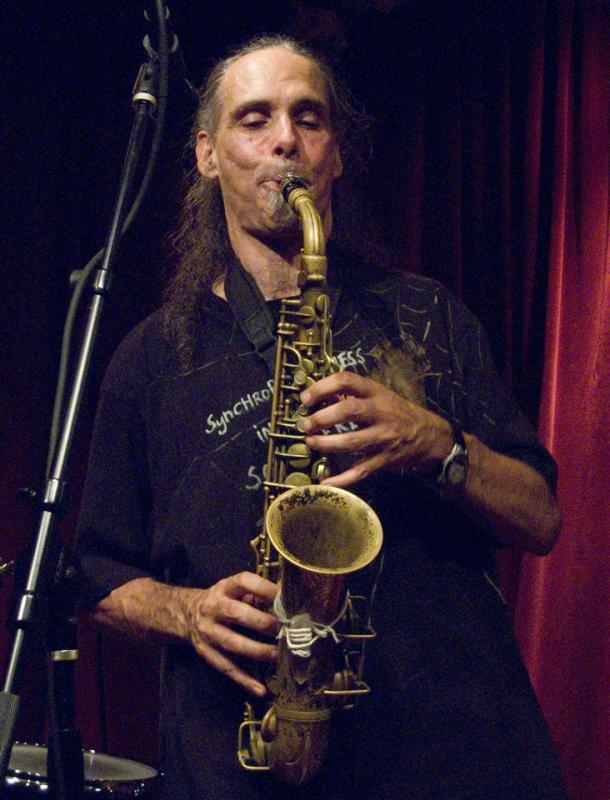Home » Jazz Articles » Interview » Patrick Brennan: Rhythms of Passion
Patrick Brennan: Rhythms of Passion
 AAJ: Where do you see your music going during the next five years, in planned projects and general direction?
AAJ: Where do you see your music going during the next five years, in planned projects and general direction? PB: Not so long after the most recent CD I did with Sonic Openings Under Pressure, [muhheankuntuk (Clean Feed, 2006)], I found myself way deep within reevaluation. I was feeling a pretty powerful lift from how that music was evolving. We'd been getting into a vocabulary potential far beyond what I would have even thought possible not very long before. But, as the music was turning even more distinctly idiolectic, it also meant that the absence of a single key musician could immobilize this entire process. Sustaining the level of intensive ensemble music that this initiative has always been about was becoming even more, rather than less, fragile. It seems that what restrains or undermines this kind of musical activity is, finally, a lot more social than it is musical.
So, I started looking around at alternatives. And, as much as I enjoy playing all kinds of music with all kinds of people, what I initiate on my own asks for different commitments with different questions. I wasn't all that inclined toward settling backward into more stereotypical and established frameworks, such as free improvisation or old school standards, even if they really are a whole lot easier to work with—and plenty of people are already doing this sort of music as it is. The option of composing for machines, or for silent stacks of score paper, leaves out the more unpredictable human elements that, for me, constitute more than half of the real substance of music. So, I opted instead to leap at something just a little more unreasonable. This was to address the ensemble compositions that the band had been playing within a solo saxophone context.
I call a lot of these ensemble platforms metagroove compositions. For example, in one stretch of "which way what:, a braking three loops into a hovering five that falls into a racing four that hits a break before looping again to five, and so forth. The overall feel that derives out of the interactions among these contrasting motion states together articulates a meta-groove. Each of these component cells are crossed with other momenta. For example, five crosses three, then three crosses five, then five crosses four. These cast each episode with multidirectional opportunities that can flow across the phrases. And, the polyrhythms are melodified in ways that can recognizably sing as well as drums.
Another construct, tilting curvaceous, modulates among variations of bars of concurrent three, four and five. Cells can sequence in a cycle, like a standard "tune" does, or each may be vamped, freely expanded, or otherwise reordered. This can provide a band with a resilient communicational syntax that can augment both an expanded freedom and an interactive coherence. The platforms might seem as complicated to explain as they may be sometimes to play, but it's not at all just some arbitrary complexity for its own sake. These are specific constellations of feels, kinetic states—less explored ways of sonic movement—thinking that really does fascinate me—and they make me stretch too. This does take some work, but it's work that opens toward a greater and greater flexibility.
Converting this into a monophonic solo language that's built out of breath and finger coordination—in contrast with a trap player's four limbs, a pianist's ten fingers or an interacting ensemble of musicians—also really deepens the kind of responsibility I've had to assume for my own musical ideas. To play these simultaneous lines and be able to develop them through improvisation has taken a few years just to get off the ground. But, what was initially daunting has become even more interesting, and finally, really exciting.
The music of course, radically changes in this context, and these constructs are continually altering how I imagine, conceive and hear. It pushes me to experiment in even more detail with something I've been musing about for a long time, which would be how the linear freedom and variety traced by Charlie Parker and Ornette Coleman, among others, could be further cross-pollinated with the kinetic and tactile depths of field projected through the expanded polyrhythmic moments of pan-African drum choirs. The simplest component takes on a noticeably different personality every time I reorganize my attention around it. And this newness just keeps on happening. Every day. A single "composition" seems to birth endless progeny. There's an awful lot of connective tissue to discover and develop here. It's another kind of thinking...almost another language.
I feel a pretty strong intuition about where this is all going. It's something felt but not yet heard. And, of course, I really don't know what it might eventually sound like. Last year, I was offered an opportunity to perform this music at Vision Festival XV, and it was very successful, so I'm even more encouraged about the musical viability of this project.
It might seem somehow paradoxical to transfer what's convivial, collective music into a solo process. But, if you're hearing a sound—feeling its conception, and no compatriots can go along with you at that moment—you either go on by yourself or you don't go there at all. Besides, no single condition is really all that permanent. And, in wondering still further about how creative possibilities open from within outsider positions, I began thinking about the Japanese Rōnin, those dispossessed samurai who continued honing their practice, even while de-contextualized by circumstances. I don't have much use at all for the terrorist applications of samurai skills, but I really do esteem their consistent self cultivation, integrity and cultivated presence of mind. I've since called this solo project of mine rōnin phasing. Where this all goes, nobody really knows. Improvise!
Selected Discography
Patrick Brennan/Sonic Openings Under Pressure, muhheankuntuk (Clean Feed, 2006)
Patrick Brennan/Sonic Openings Under Pressure, the drum is honor enough (CIMP, 2004)
Patrick Brennan/Sonic Openings Under Pressure, rapt circle (Cadence Jazz Records, 2004)
Patrick Brennan/M'allem Najib Soudani, Sudani (Deep Dish, 2000)
Patrick Brennan/Lisle Ellis, saunters, walks, ambles (CIMP, 1999)
Patrick Brennan/Sonic Openings Under Pressure, which way what (Deep Dish, 1996)
Photo Credits
Page 1: Tola Brennan
Pages 2, 5, 7, 8: Scott Friedlander
Page 3: Mitchell May
Comments
About Patrick Brennan
Instrument: Saxophone, alto
Related Articles | Concerts | Albums | Photos | Similar ToTags
Patrick Brennan
Interview
Ludwig vanTrikt
United States
Wadada Leo Smith
Duke [Ellington]
John Coltrane
Charles Gayle
[Thelonious] Monk
[Charles] Mingus
Ornette [Coleman]
[Henry] Threadgill
Sun Ra
Art Ensemble [of Chicago]
Steve Lacy
Steve Coleman
Charlie Parker
Louis Armstrong
Count Basie
Eddie Harris
Beatles
Rahsaan Roland Kirk
Dolphy
Albert Ayler
archie shepp
[Ed] Blackwell
[Charlie] Haden
Kenny Cox
duke ellington
Gary Peacock
Muhal Richard Abrams
Roscoe Mitchell
John Stubblefield
Frank Foster
Jimmy Heath
Frank Wess
john zorn
James Weidman
Jo Jones
Roy Eldridge
Cecil Taylor
Sam Rivers
Lisle Ellis
Roswell Rudd
Miles Davis
Jimmy Garrison
Ahmad Jamal
Horace Tapscott
For the Love of Jazz
 All About Jazz has been a pillar of jazz since 1995, championing it as an art form and, more importantly, supporting the musicians who create it. Our enduring commitment has made "AAJ" one of the most culturally important websites of its kind, read by hundreds of thousands of fans, musicians and industry figures every month.
All About Jazz has been a pillar of jazz since 1995, championing it as an art form and, more importantly, supporting the musicians who create it. Our enduring commitment has made "AAJ" one of the most culturally important websites of its kind, read by hundreds of thousands of fans, musicians and industry figures every month.





















